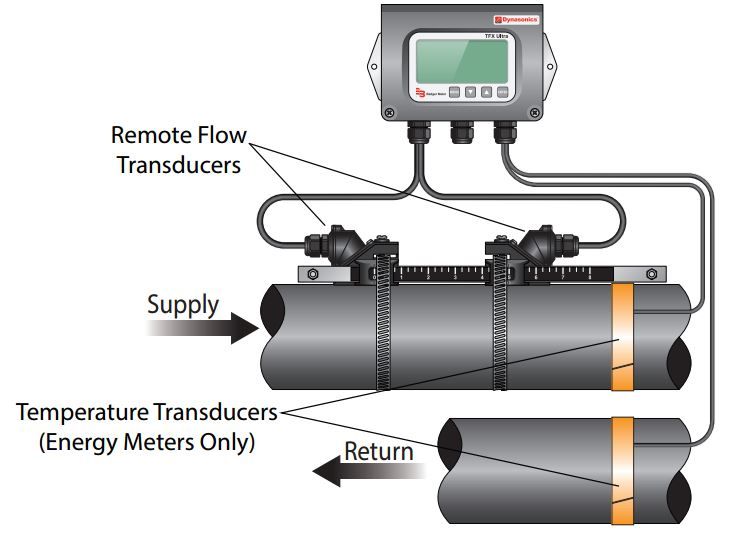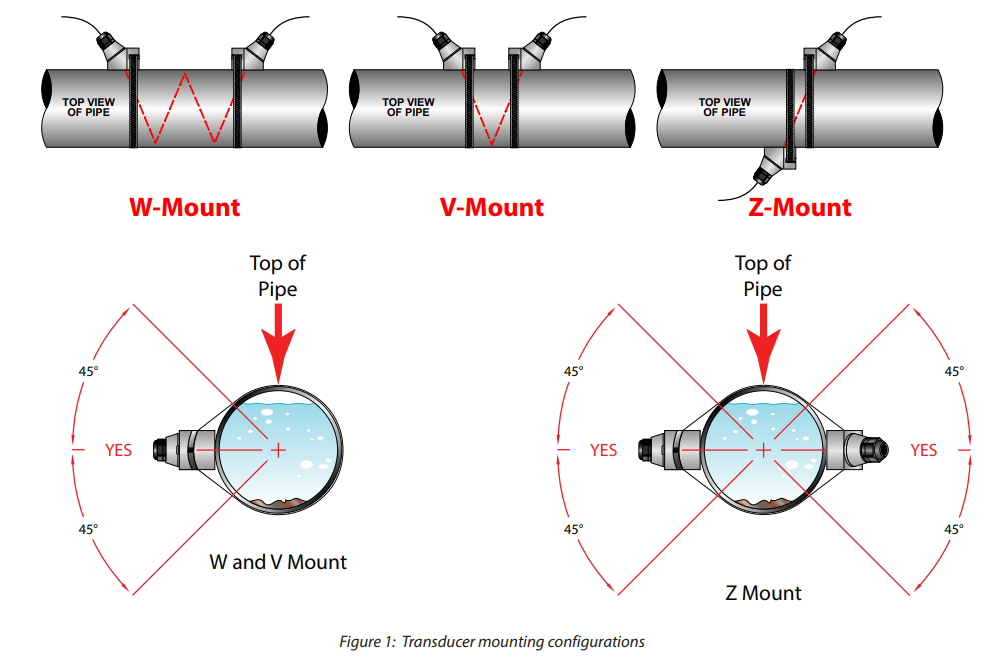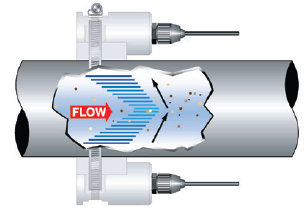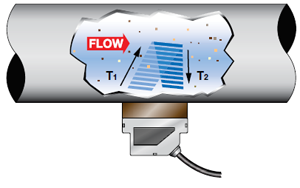Ultrasonic Flow Meter Guide
About Ultrasonic "Clamp-on" Flow Meters for liquids
Clamp on ultrasonic flow meters have become more popular throughout the water, food, chemical, process and building services industries due to their ability to measure in-situ flow rates from outside the pipework with optimum accuracy. Clamp on ultrasonic flow meters are ideal for applications when system shut down is not feasible, they are non-invasive and simply clamp on to the outside of the pipe and do not make contact with the internal fluid.
Advances in clamp on gas flow measurement technology and processing have meant that despite lower acoustic impedance levels and higher attenuation levels in most gases, a clamp on gas flow meter can now measure transit times in gases where signal-to-noise ratios are extremely low. It is now possible to measure natural gas, steam, compressed air, hydrogen, compressed air and many more using clamp on flow meters.
How do Ultrasonic Flow Meters work (Time of Flight) ?
They measure the time it takes for an ultrasonic signal transmitted from one sensor, to cross a pipe and be received by a second sensor.

Figure 1: Time of flight Ultrasonic sensors- W Mount
Figure 2: Typical Ultrasonic Flow Meter "clamp-on" sensor arrangements for Time of Flight variety
Transit time or Time of Flight flow meters utilize two transducers which function as both ultrasonic transmitters and receivers. The flow meters operate by alternately transmitting and receiving a frequency modulated burst of sound energy between the two transducers. The burst is first transmitted in the direction of fluid flow and then against fluid flow. Since sound energy in a moving liquid is carried faster when it travels in the direction of fluid flow (downstream) than it does when it travels against fluid flow (upstream), a differential in the times of flight will occur.
The sound's time of flight is accurately measured in both directions and the difference in time of flight calculated. The liquid velocity (V) inside the pipe can be related to the difference in time of flight (dt) through the following equation: V = K * D * dt, where K is a constant and D is the distance between the transducers
Advantages: (Time of Flight Principle)
♦ Measures a wide range of non-aerated and clean liquids (Gas capable models also available)
♦ Ability to measure liquids with small amounts of suspended solids or aeration (e.g., surface water, sewage).
♦ Measures virtually any liquid that is sonically conductive.
♦ Bi-directional flow measurement.
♦ High Pressure is not a problem consideration, as the sensors are clamped onto the outside of the pipe.
♦ Heat Energy metering versions are available for non-intrusive measurement of BTU's, kWh's
♦ Liquid compatibility is not an issue, as the sensors are clamped onto the outside of the pipe.
♦ Suitable for high temperature applications - transducer dependant
♦ Pressure drop is not a consideration, as the sensors are clamped onto the outside of the pipe.
♦ MID approved clamp-on ultrasonic flow meter models are now available
♦ Suitable for hazardous areas
♦ Inherently hygienic as they clamp onto the pipe exterior
♦ Low cost of ownership with zero system down-time during installation / maintenance
♦ Easy to install by non engineers and can be moved around plant locations
♦ Proven design getting better and cheaper all the time
♦ A wide selection of output protocols are available for connection to data loggers, displays and remote systems
♦ Integrated or remote LCD display and battery powered portable models are available
Disadvantages:
♦ Pulsating flows are not tolerated very well and can affect the signal quality & readings
♦ Dependant on intersecting the average flow profile (therefore, flow conditioning is required eg, straight pipe lengths or diffusers)
♦ Not suitable for liquids with entrained air as false readings will result (some models are more tolerant than others)
♦ Not suitable for liquids with suspended solids (some models are more tolerant than others)
♦ Very small diameter pipes and low velocity (< 2ft/sec) applications are not always suitable- model dependant
♦ The scaling, pitting, and fouling that can occur over time in older piping systems can be problematic.
♦ Pipes with heavy corrosion, external coatings and internal liners can all prove problematic for this technology
♦ Full pipe flow is required
Typical applications:
Clamp-on ultrasonic flow meters measure a wide range of fluids and gases, such as:
• Ultra-pure water.
• Sewage and wastewater.
• Steam
• Towns gas
• High viscosity liquids.
• Corrosive liquids.
• Abrasive liquids
• Beverages
• Cooling Water
• Compressed air
• Food/Hygienic flow-monitoring
• Inspection of fixed installation meters
| View our range of Ultrasonic Flow Meters |
How do Ultrasonic Flow Meters work (Doppler)
Doppler principle ultrasonic flow meters are designed to measure the flow of liquids that contain sound reflectors eg. suspended solids or air bubbles
Figure 1: Doppler Ultrasonic Flow Meter (Two transducers)
Figure 2: Doppler Ultrasonic Flow Meter (Single transducer)
Each Doppler flow meter utilizes two piezoelectric crystals contained within either two separate transducer heads (Figure 1) or one transducer head (Figure 2) Sound is transmitted from one of the crystals, reflected by useful sonic reflectors suspended within the liquid and recorded by the receiving transducer. If the reflectors are moving within the sound transmission path, sound waves will be reflected at a frequency shifted (Doppler shift) from the transmitted frequency.
The difference between the reflected frequencies and transmitted frequencies is directly proportional to the speed of the sonic reflectors, resulting in a liquid flow rate that is converted to various user defined measuring units.
Advantages: (Doppler Principle)
♦ Measures a wide range of aerated liquids and liquids with suspended solids
♦ High Pressure is not a problem consideration, as the sensors are clamped onto the outside of the pipe.
♦ Liquid compatibilityis not an issue, as the sensors are clamped onto the outside of the pipe.
♦ Suitable for high temperature applications - transducer dependant
♦ Pressure drop is not a consideration, as the sensors are clamped onto the outside of the pipe.
♦ Inherently hygienic as they clamp onto the pipe exterior
♦ Low cost of ownership with zero system down-time during installation / maintenance
♦ Easy to install by non engineers and can be moved around plant locations
♦ Integrated or remote LCD display and battery powered portable models are available
Disadvantages:
♦ Not suitable for clean liquids without suspended solids or bubbles
♦ Dependant on intersecting the average flow profile (therefore, flow conditioning is required eg, straight pipe lengths before and after)
♦ Very small diameter pipes and low velocity applications are not always suitable- model dependant
♦ Measurements affected by sound velocity changes due to temperature, density and concentration
♦ The scaling, pitting, and fouling that can occur over time in older piping systems can be problematic.
♦ Full pipe flow is required and a minimum flow velocity is required
Typical applications:
Doppler ultrasonic flow meters measure a wide range of fluids, including liquids such as:
• Sewage and wastewater.
• Slurries
• Corrosive liquids.
• Abrasive liquids with suspended solids
• Irrigation Water
| View our range of Ultrasonic Doppler Flow Meters |





